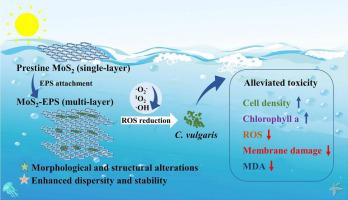NanoImpact ( IF 4.9 ) Pub Date : 2023-09-29 , DOI: 10.1016/j.impact.2023.100485 Manman Cao 1 , Donghong Yang 2 , Fei Wang 1 , Beihai Zhou 2 , Huilun Chen 2 , Rongfang Yuan 2 , Ke Sun 1

|
Although the toxic effects of two-dimensional nanomaterials (2D-NMs) have been widely reported, the influence of extracellular polymeric substances (EPS) on the environmental fate and risk of 2D-NMs in aquatic environments is largely unknown, and the processes and mechanisms involved remain to be revealed. Herein, we investigated the impact of EPS secreted by microalgae (Chlorella vulgaris (C. vulgaris)) on the environmental transformation and risk of molybdenum disulfide (MoS2). We found that the attachment of EPS increased the thickness of MoS2 (from 2 nm to 5 nm), changed it from a monolayer sheet to a fuzzy multilayer structure, and promoted the formation of defects on MoS2. The blue-shift of the peak associated with the plasmon resonances in the 1 T phase and the generation of electron-hole pairs suggested that EPS altered the surface electronic structure of MoS2. EPS interacted mainly with the S atoms on the 1 T phase, and the attachment of EPS promoted the oxidation of MoS2. The reduction in hydrodynamic diameter (Dh) and the decrease in zeta potential indicated that EPS inhibited the agglomeration behavior of MoS2 and enhanced its dispersion and stability in aqueous media. Notably, EPS reduced the generation of free radicals (superoxide anion (•O2−), singlet oxygen (1O2), and hydroxyl radicals (•OH−)). Furthermore, EPS mitigated the toxicity of MoS2 to C. vulgaris, such as attenuated reduction in biomass and chlorophyll content. Compared to pristine MoS2, MoS2 + BG11 + EPS exhibited weaker oxidative stress, membrane damage and lipid peroxidation. The adsorption of EPS on MoS2 surface reduced the attachment sites of MoS2, making MoS2 less likely to be enriched on the cell surface. The findings have significant contribution for understanding the interactions between EPS and MoS2 in aquatic ecosystems, providing scientific guidance for risk assessment of 2D-NMs.
中文翻译:

胞外聚合物改变二硫化钼纳米材料的理化性质以减轻其对小球藻的毒性
尽管二维纳米材料(2D-NMs)的毒性作用已被广泛报道,但细胞外聚合物(EPS)对水生环境中2D-NMs的环境命运和风险的影响很大程度上未知,其过程和机制涉及的内容还有待揭晓。在此,我们研究了微藻(小球藻(C. vulgaris))分泌的EPS对二硫化钼(MoS 2 )环境转化和风险的影响。我们发现EPS的附着增加了MoS 2的厚度(从2 nm到5 nm),将其从单层片状结构转变为模糊的多层结构,并促进了MoS 2 上缺陷的形成。与 1 T 相中的等离激元共振相关的峰蓝移和电子空穴对的产生表明 EPS 改变了 MoS 2 的表面电子结构。EPS主要与1 T相上的S原子相互作用,EPS的附着促进了MoS 2的氧化。流体动力学直径( D h )的减小和zeta电位的降低表明EPS抑制了MoS 2的团聚行为并增强了其在水介质中的分散性和稳定性。值得注意的是,EPS 减少了自由基(超氧阴离子 (•O 2 - )、单线态氧 ( 1 O 2 ) 和羟基自由基 (•OH - ))的产生。此外,EPS减轻了MoS 2对普通念珠菌的毒性,例如减弱了生物量和叶绿素含量的降低。与原始MoS 2相比,MoS 2 + BG11 + EPS 表现出较弱的氧化应激、膜损伤和脂质过氧化。EPS在MoS 2表面的吸附减少了MoS 2的附着位点,使得MoS 2不太可能在细胞表面富集。该研究结果对于理解水生生态系统中EPS和MoS 2之间的相互作用具有重要贡献,为2D-NMs的风险评估提供科学指导。



























 京公网安备 11010802027423号
京公网安备 11010802027423号